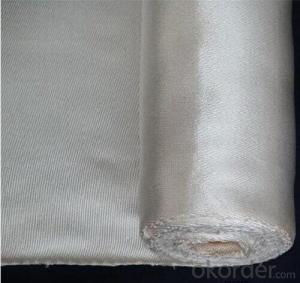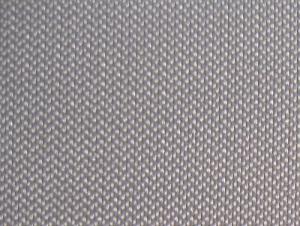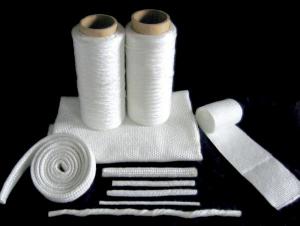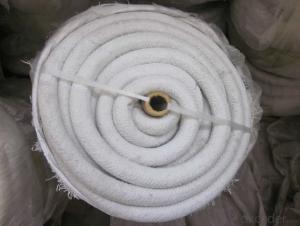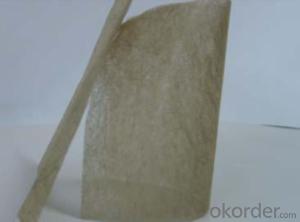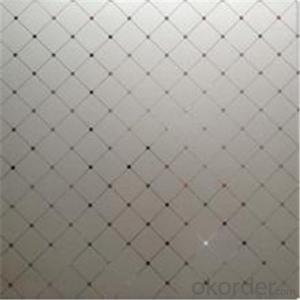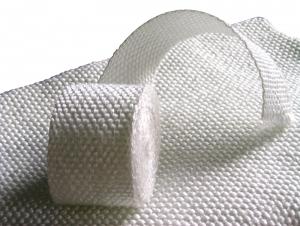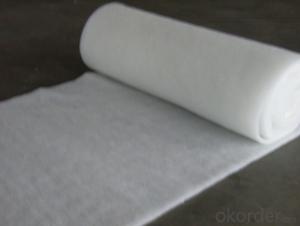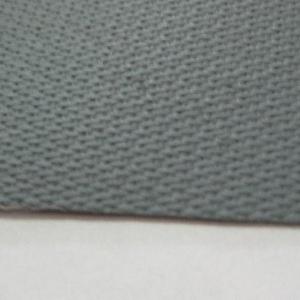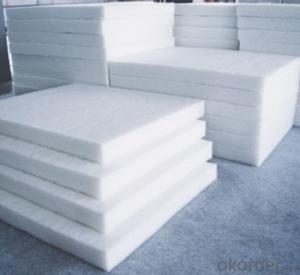Alumina Coated Glass Fiber Fabric Product
- Loading Port:
- Qingdao
- Payment Terms:
- TT OR LC
- Min Order Qty:
- 500 m²
- Supply Capability:
- 3000 m²/month
OKorder Service Pledge
OKorder Financial Service
You Might Also Like
Alumina Coated Fiberglass Fabric is made of important fiberglass as the wearing material to plain knit or specially knit into superior fiberglass basic cloth,coat it with fine PTFE resin then make it into various of Teflon high temperature resistance cloth in different thickness and width .
Besides ,having the grate capability of antisepsis and heat resistant, the surface is more smoothly and it has better non-viscidity capability. It could be used in ordinary industry field, and has better predominance on being used as plastic module separating, and separating patch, gasket, separating module of some products.
PRODUCT FEATURES AND BENEFITS*
* stable dimension, high intensity, elongation coefficient less 5%
* good temperature resistance,24 hours working temperature -70~260oC
* low coefficient of friction and dielectric constant, good insulating ability
* non-stick, easy to clear stains and adhensive on the surface
* good chemical resistance, it can resist all most of chemical medicines, acids, alkalis and salt, it is fireproof, lower in aging.
*With excellent heat resistance, rub resistance, high insulation properties, high tensile strength, oil resistance, corrosion resistance, flame resistance, non-halogen properties
Model | Thickness (mm) | Color | Width (mm) | Normal Weight (g/m²) | Tensile strength (N/cm) | Peeling strength (N/25mm) | Heat resistance (℃) |
CT - TF008 | 0.08 |
Brown *White *Black *Beige
| 1250 | 150 | 180/140 | 6.5-9.5 | -60~260 |
CT-TF013 | 0.13 | 1250 | 260 | 290/260 | 6.5-9.5 | -60~260 | |
CT-TF015 | 0.15 | 1250 | 300 | 310/260 | 6.5-9.5 | -60~260 | |
CT-TF018 | 0.18 | 1250 | 330 | 400/260 | 6.5-9.5 | -60~260 | |
CT-TF025 | 0.25 | 2800 | 450 | 550/500 | 6.5-9.5 | -60~260 | |
CT-TF035 | 0.35 | 3200 | 700 | 650/600 | 6.5-9.5 | -60~260 | |
CT-TF040 | 0.40 | 3500 | 780 | 820/500 | 6.5-9.5 | -60~260 | |
CT-TF065 | 0.65 | 4000 | 1100 | 880/730 | 6.5-9.5 | -60~260 | |
CT-TF09 | 0.9 | 4000 | 1500 | 1050/950 | 6.5-9.5 | -60~260 |
- Q:Can glass fiber textiles be used for reinforcement in plastic bottles?
- Yes, glass fiber textiles can indeed be used for reinforcement in plastic bottles. Glass fiber textiles, also known as fiberglass, are lightweight, strong, and durable materials that are commonly used in various industries, including automotive, aerospace, and construction. When incorporated into plastic bottles, glass fiber textiles can enhance their structural integrity and reduce the risk of deformation or breakage. The glass fibers add strength and stiffness to the plastic matrix, making the bottles more resistant to impact, pressure, and temperature changes. Additionally, glass fiber reinforcement can help to reduce the amount of plastic required in the bottle's construction, making it a more sustainable option. However, it is important to note that the addition of glass fibers may affect the transparency of the plastic bottle, as the fibers can cause a slight opacity. Therefore, if transparency is a crucial factor, alternative reinforcement materials such as carbon fiber or aramid fibers may be preferred.
- Q:How do glass fiber textiles perform in terms of thermal insulation?
- Glass fiber textiles are known to have excellent thermal insulation properties. Due to their composition, which includes fine strands of glass, they are able to trap air effectively within their structure. This trapped air acts as an insulating barrier, reducing heat transfer through conduction and convection. Consequently, glass fiber textiles can help to maintain stable temperatures in both hot and cold environments. Additionally, their low thermal conductivity ensures minimal heat loss or gain, making them highly efficient in conserving energy and reducing heating or cooling costs. Overall, glass fiber textiles are widely recognized for their superior thermal insulation capabilities.
- Q:Can glass fiber textiles be used in window blinds or shades?
- Yes, glass fiber textiles can be used in window blinds or shades. Glass fiber textiles are known for their durability, strength, and resistance to temperature fluctuations and UV rays. These qualities make them an ideal material for window treatments such as blinds or shades. Glass fiber textiles can effectively block out sunlight, reduce heat transfer, and provide privacy. Additionally, they are resistant to fading and can be easily cleaned, making them a practical choice for window coverings.
- Q:How does the fiber length affect the properties of glass fiber textiles?
- The properties of glass fiber textiles are impacted by the length of their fibers. To begin with, longer fiber lengths generally result in stronger and more durable textiles. This is because the longer fibers interlock and bond within the fabric, increasing its tensile strength and making it more resistant to tearing or breaking when under stress. Additionally, longer fibers provide better flexibility and improved drapability to the fabric. They can be woven or knitted into complex patterns with greater ease, allowing the textile to be shaped and molded as required. This is especially important for applications where the fabric needs to conform to different shapes or be used in structural components. Moreover, longer fiber lengths enhance the thermal and electrical conductivity of glass fiber textiles. They provide a larger surface area for heat or electricity to transfer through the fabric. This is advantageous in applications where thermal insulation or electrical conductivity is necessary. However, it is important to consider the limitations of longer fiber lengths. They can make the textile stiffer and less comfortable to wear, reducing its suitability for clothing or soft furnishings. The longer fibers can also increase the weight of the fabric, making it less suitable for lightweight or high-performance applications. In conclusion, the choice of fiber length is crucial in determining the strength, durability, flexibility, thermal conductivity, and electrical conductivity of glass fiber textiles. It should be carefully considered based on the desired properties and specific requirements of the application.
- Q:Can glass fiber textiles be used for medical applications?
- Glass fiber textiles have the ability to be utilized in medical applications. These textiles are created by weaving together fine strands of glass fibers to produce a fabric. There are several qualities of these textiles that make them appropriate for medical use. Firstly, glass fiber textiles are biocompatible, which means they are unlikely to cause any negative reactions when they come into contact with the human body. This characteristic is crucial for medical applications as it guarantees that the textile will not cause any harm or discomfort to the patient. Secondly, glass fiber textiles possess resistance to chemicals and can endure processes of sterilization, such as autoclaving. This makes them ideal for use in medical environments where maintaining sterility is of utmost importance, such as surgical gowns, drapes, or wound dressings. Moreover, glass fiber textiles exhibit exceptional strength and durability, making them appropriate for use in medical devices and implants. For instance, they can be utilized to reinforce prosthetic limbs, create orthopedic braces, or serve as a component in surgical sutures. Additionally, glass fiber textiles possess thermal insulation properties, which can be advantageous in medical applications. They can be employed as insulation in medical devices that are sensitive to temperature or in the construction of incubators and thermal blankets for premature infants. In conclusion, glass fiber textiles can be employed in various medical applications due to their biocompatibility, resistance to chemicals, strength, durability, and thermal insulation properties. Their adaptability and suitability for medical use make them a viable choice for enhancing healthcare and improving patient outcomes.
- Q:How are glass fiber textiles used in the aerospace industry?
- Due to their exceptional properties and versatility, glass fiber textiles are extensively utilized in the aerospace industry. These textiles, composed of fine strands of glass, possess remarkable attributes such as high strength-to-weight ratio, corrosion resistance, and exceptional thermal and electrical insulation. Within the aerospace industry, glass fiber textiles have diverse applications. One primary application involves their integration with resins to manufacture composite materials, resulting in the creation of sturdy and lightweight structures. These composites are crucial for constructing key aircraft components like wings, fuselages, and tail sections. By incorporating glass fiber textiles, the overall strength and stiffness of these structures are enhanced, leading to improved load distribution and enhanced fuel efficiency. Moreover, glass fiber textiles are valuable in producing thermal and acoustic insulation materials for aerospace purposes. These textiles effectively regulate temperature within the aircraft, affording protection to critical components against extreme heat or cold. Additionally, they contribute to reducing noise levels by absorbing and dampening sound waves, consequently providing a quieter and more comfortable flying experience. Additionally, glass fiber textiles are utilized in the fabrication of protective covers and shields for sensitive equipment and instruments employed in the aerospace industry. These textiles serve as lightweight yet durable barriers against environmental factors including electromagnetic interference, radiation, and moisture. By safeguarding critical electronic components, they ensure proper functionality and longevity. In summary, glass fiber textiles play a pivotal role in the aerospace industry, enabling the production of robust, lightweight, and high-performance materials. Their utilization in composites, insulation, and protective applications significantly enhances the safety, efficiency, and reliability of aircraft, thus making them an indispensable component of modern aerospace technology.
- Q:Can glass fiber textile be used in solar panels?
- Glass fiber textile is indeed suitable for utilization in solar panels. Possessing outstanding electrical insulation properties, this lightweight and flexible material can serve as a substrate or backing for solar panels, providing valuable structural support and safeguarding the fragile solar cells. By incorporating glass fiber textile, the longevity of solar panels is enhanced, as it resists weathering, moisture, and UV radiation. Furthermore, the flexibility of glass fiber textile facilitates seamless integration into diverse solar panel designs, offering increased installation options. Consequently, the utilization of glass fiber textile in solar panels contributes significantly to their overall efficiency and durability.
- Q:Can glass fiber textiles be used in the fashion industry?
- Glass fiber textiles, also known as fiberglass textiles, have the potential to be utilized in the fashion industry. These textiles are created by weaving strands of glass fibers together. They are distinguished by their strength, durability, and ability to withstand high temperatures. In the fashion realm, glass fiber textiles are predominantly employed for the purpose of crafting distinctive and inventive designs. They can be utilized in the production of clothing, accessories, and even footwear. One of the key benefits of integrating glass fiber textiles into fashion is their capacity to produce lightweight and breathable garments. Despite their durability, glass fiber textiles are generally lighter in weight compared to conventional fabrics such as cotton or polyester. This quality makes them ideal for designing comfortable garments that still offer structural support. Glass fiber textiles also offer a wide array of design possibilities. They can be molded into various shapes and patterns, enabling fashion designers to create intricate and elaborate designs. Additionally, glass fiber textiles can be combined with other materials such as fabrics, metals, or plastics to create distinctive textures and finishes. Moreover, glass fiber textiles possess excellent mechanical properties, making them well-suited for producing fashion pieces that require stability and structure. For instance, they can be employed in the creation of corsets, bodices, or other garments that necessitate maintaining their shape. However, it is important to acknowledge that glass fiber textiles do have some limitations. They are not as flexible as traditional fabrics, which can restrict movement in certain garments. Additionally, wearing glass fiber textiles directly against the skin may not be as comfortable, which is why they are often utilized in conjunction with other materials to provide comfort. To summarize, glass fiber textiles can indeed be utilized in the fashion industry. Their strength, durability, and potential for unique designs make them a valuable material for producing innovative and visually striking fashion pieces.
- Q:Can glass fiber textiles be used in reinforcement of carbon fibers?
- Hybrid composites, which consist of glass fiber textiles and carbon fibers, are commonly used for reinforcement purposes. The utilization of glass fiber textiles alongside carbon fibers can yield numerous benefits. First and foremost, glass fibers are a cost-effective alternative to carbon fibers, as they are relatively inexpensive. This affordability makes glass fibers a viable choice in applications where cost plays a significant role. Moreover, glass fibers possess exceptional mechanical properties, including high tensile strength and stiffness. By combining them with carbon fibers, the resulting hybrid composite exhibits enhanced mechanical properties compared to utilizing carbon fibers alone. This, in turn, leads to improved structural integrity and performance in a variety of applications. Furthermore, glass fiber textiles contribute to the impact resistance and fracture toughness of the composite. With their greater resistance to impact, glass fibers aid in preventing delamination or cracking in the carbon fiber matrix. Nevertheless, it is crucial to consider the specific requirements of each application when choosing reinforcement materials. While glass fibers offer certain advantages, they have lower specific strength and stiffness in comparison to carbon fibers. In cases where weight reduction is of utmost importance, utilizing carbon fibers alone or in combination with other high-performance fibers may be more suitable. To summarize, glass fiber textiles can indeed be utilized for reinforcing carbon fibers, resulting in a cost-effective solution with improved mechanical properties and impact resistance.
- Q:What are the different thickness options for glass fiber textile?
- Glass fiber textile comes in a variety of thickness options to accommodate different applications and requirements. Typically, the thickness of glass fiber textile is measured in grams per square meter (gsm) or ounces per square yard (oz/yd²). The range of thickness options for glass fiber textile is commonly from 100 gsm to 600 gsm (3 oz/yd² to 18 oz/yd²). These thicknesses are suitable for a wide range of applications, including composites reinforcement, insulation, and filtration. For lightweight applications that require minimal reinforcement, lower thicknesses of glass fiber textile, such as 100 gsm to 200 gsm (3 oz/yd² to 6 oz/yd²), are commonly used. Industries like automotive, aerospace, and marine often utilize these thinner textiles where weight reduction is crucial. Medium thickness options for glass fiber textiles, ranging from 200 gsm to 400 gsm (6 oz/yd² to 12 oz/yd²), are ideal for general reinforcement purposes. These textiles offer a balance between strength and weight, making them versatile for applications like boat building, wind turbine blades, and sporting goods. Thicker glass fiber textiles are employed for heavy-duty applications that require maximum strength and durability. These textiles typically range from 400 gsm to 600 gsm (12 oz/yd² to 18 oz/yd²) and are commonly used in industries such as construction, oil and gas, and infrastructure. They are utilized for applications like concrete reinforcement, pipe wrapping, and geotextiles. It is important to note that manufacturers may offer additional thickness options beyond the mentioned range, depending on specific customer needs. In some cases, custom thicknesses can also be ordered. Ultimately, the choice of glass fiber textile thickness depends on the intended application, required strength, and weight considerations. Seeking guidance from a supplier or field expert can help determine the most suitable thickness option for a particular project.
1. Manufacturer Overview |
|
|---|---|
| Location | |
| Year Established | |
| Annual Output Value | |
| Main Markets | |
| Company Certifications | |
2. Manufacturer Certificates |
|
|---|---|
| a) Certification Name | |
| Range | |
| Reference | |
| Validity Period | |
3. Manufacturer Capability |
|
|---|---|
| a)Trade Capacity | |
| Nearest Port | |
| Export Percentage | |
| No.of Employees in Trade Department | |
| Language Spoken: | |
| b)Factory Information | |
| Factory Size: | |
| No. of Production Lines | |
| Contract Manufacturing | |
| Product Price Range | |
Send your message to us
Alumina Coated Glass Fiber Fabric Product
- Loading Port:
- Qingdao
- Payment Terms:
- TT OR LC
- Min Order Qty:
- 500 m²
- Supply Capability:
- 3000 m²/month
OKorder Service Pledge
OKorder Financial Service
Similar products
New products
Hot products
Related keywords
